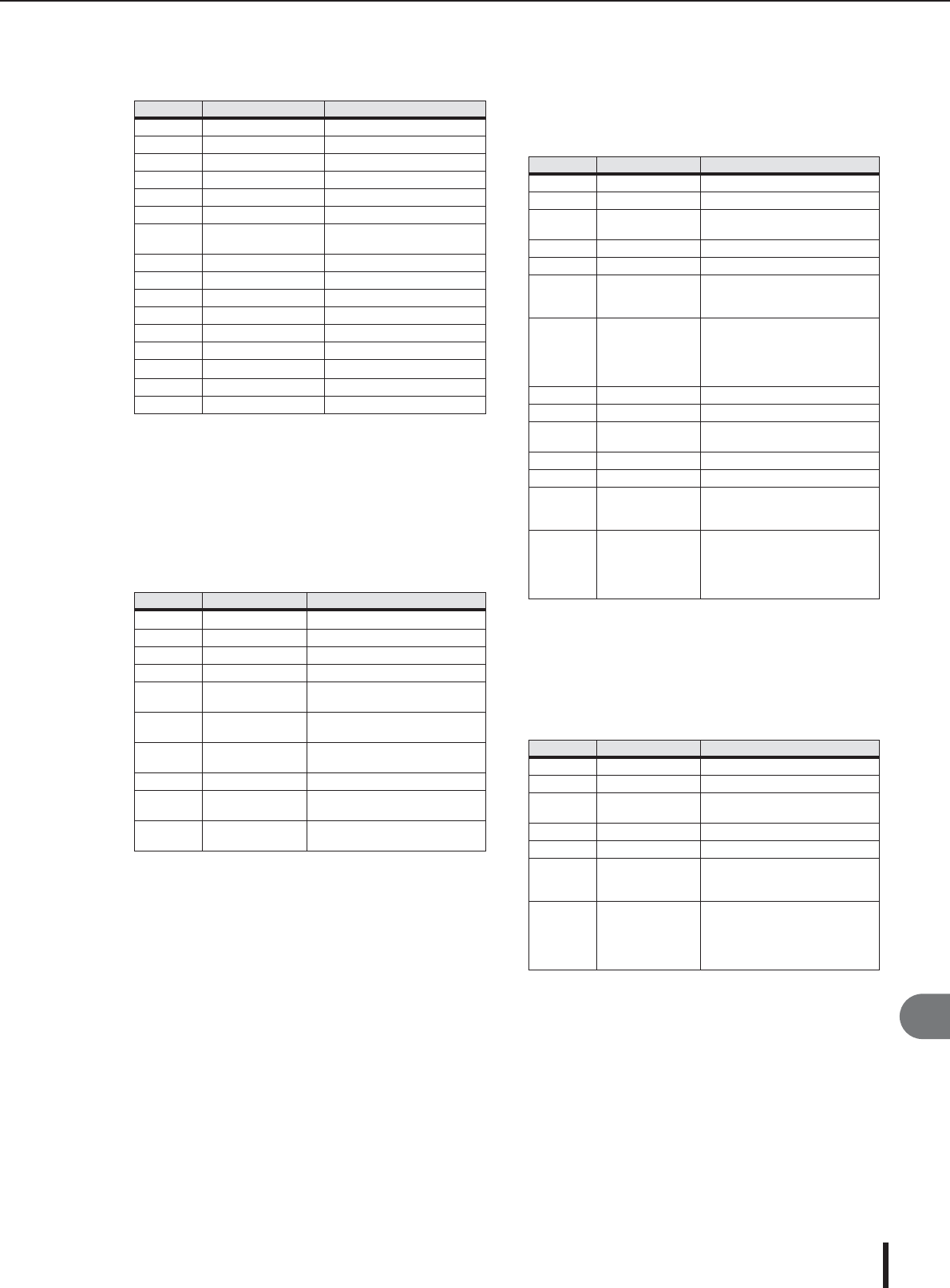
Effects Parameters
M7CL Owner’s Manual
263
Appendices
■ M.BAND COMP
Two input, two output 3-band compressor, with individ-
ual solo and gain reduction metering for each band.
■ REV-X HALL, REV-X ROOM, REV-X PLATE
Newly-developed two input, two output reverb algorithm.
Delivers dense and rich reverberation, smooth decay, and
provides a spaciousness and depth that enhances the origi-
nal sound. Choose from three types depending on your
location and needs; REV-X HALL, REV-X ROOM, and
REV-X PLATE.
■ COMP276
This effect emulates the characteristics of analog com-
pressors that are widely used in recording studios. It will
produce a thick, strong frame sound suitable for drums
and bass. You can control two monaural channels indepen-
dently.
■ COMP276S
This effect emulates the characteristics of analog com-
pressors that are widely used in recording studios. It pro-
duces a thick, strong frame sound suitable for drums and
bass. You can link and control the L and R channel param-
eters.
Parameter Range Description
LOW GAIN –96.0 to +12.0 dB Low band level
MID GAIN –96.0 to +12.0 dB Mid band level
HI. GAIN –96.0 to +12.0 dB High band level
L-M XOVR 21.2 Hz–8.00 kHz Low/mid crossover frequency
M-H XOVR 21.2 Hz–8.00 kHz Mid/high crossover frequency
SLOPE –6 dB, –12 dB Filter slope
CEILING –6.0 dB to 0.0 dB, OFF
Specifies the maximum output
level
LOOKUP 0.0–100.0 ms Lookup delay
LOW THRE –54.0 dB to 0.0 dB Low band threshold level
MID THRE –54.0 dB to 0.0 dB Mid band threshold level
HI. THRE –54.0 dB to 0.0 dB High band threshold level
RATIO 1:1 to 20:1 Compression ratio
ATTACK 0–120 ms Compressor attack time
RELEASE
*1
*1. 6.0 ms–46.0 s (fs=44.1 kHz), 5.0 ms–42.3 s (fs=48 kHz)
Compressor release time
KNEE 0–5 Compressor knee
BYPASS OFF/ON Bypasses the compressor
Parameter Range Description
REV TIME
0.28–27.94 s
*1
*1. These values are for when the effect type is REV-X HALL and the
ROOM SIZE=28. The range will differ depending on the effect type
and ROOM SIZE setting.
Reverb time
INI. DLY 0.0–120.0 ms Initial delay before reverb begins
HI. RATIO 0.1–1.0 High-frequency reverb time ratio
LO. RATIO 0.1–2.4 Low-frequency reverb time ratio
LO.FREQ 22.0 Hz–18.0 kHz
Frequency point for LO.RATIO set-
ting
DIFF. 0–10
Reverb diffusion (left–right reverb
spread)
ROOM
SIZE
0–28 Size of room
DECAY 0–53 Gate closing speed
HPF
THRU, 22.0 Hz–
8.00 kHz
High-pass filter cutoff frequency
LPF
1.00 kHz–
18.0 kHz, THRU
Low-pass filter cutoff frequency
Parameter Range Description
INPUT 1 –180.0 to 0 dB Adjusts the CH1 input level
OUTPUT 1 –180.0 to 0 dB Adjusts the CH1 output gain
RATIO 1
2:1, 4:1, 8:1, 12:1,
20:1
Ratio for CH1 compressor
ATTACK 1 0.022–50.4 ms Attack time for CH1 compressor
RELEASE1 10.88–544.22 ms Release time for CH1 compressor
MAKE UP1 OFF, ON
Automatically corrects output
gain reduction when CH1 com-
pressor is applied
SIDEHPF1 OFF, ON
When the HPF in the side chain of
the CH1 compressor is turned on,
the compression applied to the
low range will be weakened, thus
emphasizing the low range.
INPUT 2 –180.0 to 0 dB Adjusts the CH2 input level
OUTPUT 2 –180.0 to 0 dB Adjusts the CH2 output gain
RATIO 2
2:1, 4:1, 8:1, 12:1,
20:1
Ratio of CH2 compressor
ATTACK 2 0.022–50.40 ms Attack time of CH2 compressor
RELEASE2 10.88–544.22 ms Release time of CH2 compressor
MAKE UP2 OFF, ON
Automatically corrects output
gain reduction when the CH2
compressor is applied
SIDEHPF2 OFF, ON
When the HPF in the side chain of
the CH2 compressor is turned on,
the compression applied to the
low range will be weakened, thus
emphasizing the low range.
Parameter Range Description
INPUT –180.0 to 0 dB Adjusts the input level
OUTPUT –180.0 to 0 dB Adjusts the output gain
RATIO
1:2, 4:1, 8:1, 12:1,
20:1
Ratio of the compressor
ATTACK 0.022–50.40 ms Attack time of the compressor
RELEASE 10.88–544.22 ms Release time of the compressor
MAKE UP OFF, ON
Automatically corrects output
gain reduction when the com-
pressor is applied
SIDE HPF OFF, ON
When the HPF in the side chain of
the compressor is turned on, the
compression applied to the low
range will be weakened, thus
emphasizing the low range.


















